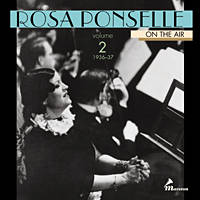
Rosa Ponselle
On the Air, Volume 2 1936-1937
Rosa Ponselle (1897-1981) was arguably this century's greatest soprano. Artists such as Callas and Caruso acknowledged her vocal supremacy. Ponselle's voice had volume, beauty, emotion, sure intonation and remarkable flexibility. This two CD-set chronicles the second volume of her on the air recordings from 1936-1937. By Ponselle's own account, her broadcasts captured her true voice and she preferred these performances to her numerous commercial recordings. This set has been produced in association with the Rosa Ponselle Foundation and a portion of the sales will go to the Rosa Ponselle Scholarship Fund.
A Note from Ward Marston
|
Today, anyone who owns a cassette or VCR recorder has probably taped programs off the radio or television. It has become as simple as inserting a tape into the machine and pressing a button. Prior to the advent of magnetic tape however, recording off the air was not such an easy matter. By the mid-1920s, radio and recordings had become competing forms of home entertainment, and all but the poorest households could boast a radio and a record player. The development of the electrical recording process made it feasible to record radio broadcasts, but this could only be accomplished by cutting a wax master and having it plated and pressed, in exactly the way that commercial recordings were produced. There was, as yet, no method for making recordings that could be immediately played back. During this period, the major record companies made recordings of broadcasts of important events yet few of these were actually issued to the public. There are also cases of individuals or corporations hiring record companies to make custom recordings of particular broadcasts. Because of the expense involved in such an undertaking, occurrences of this sort were very few. During the early 1930s, two methods for making instantaneous playback disc recordings were developed. The first utilized pre-grooved discs and a special cutting head that attached to an ordinary record player. This method produced very poor results and was only meant for home-use. Radio stations and recording studios specializing in instantaneous recording used a more sophisticated process that involved cutting groves into an aluminum disc. The quality of sound on these discs was not as high as a commercial recording but was quite remarkable for the time, and by 1934, musical artists were beginning to request radio stations to provide them with recordings of their broadcasts. This type of disc was soon replaced by an improved aluminum disc coated with acetate, which was capable of capturing much higher frequencies. Owing to the novelty of these recordings, most were completely ruined by repeated playback with blunt needles, and relatively few broadcasts from this early period exist in listenable sound. The recordings contained in this set were transferred, whenever possible, from original aluminum and acetate discs. Only when absolutely necessary have I used secondary sources. The only source for the 24 May 1936 General Motors Hour is a set of severely damaged discs. I have included this material with my apology for the poor sound for the sake of completeness. I have also included all available introductory announcements in order to convey the atmosphere of the original broadcast. The sound track for Rosa Ponselle’s MGM Screen Test was taken directly from the original 16 MM print. | ||